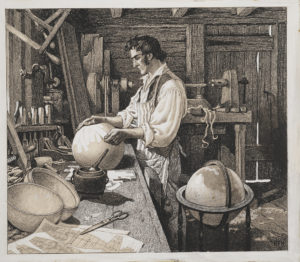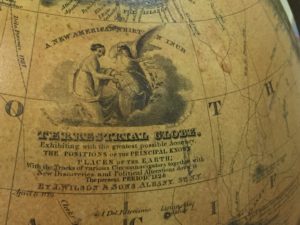
Howell’s “Bi-Centennial History of Albany” says that the Wilson boys of Albany, John and Samuel, were the sons of the first globe manufacturer in the U.S. That would have been James Wilson, born in Londonderry, N.H., and died in Bradford, Vt. According to Howell, around 1820 sons John and Samuel established a globe manufactory in Albany, “the first of the kind in this country.” It clearly wasn’t. Then Howell plagiarizes Munsell, who had listed the death of John (March 18, 1833) in his “Notes from the Newspapers” section in the Annals: “It was claimed for them that they were the best globe-makers, not only in America, but in the world. So much did they improve the art of globe-making as to elicit the admission of English manufacturers, that their globes were geographically and mechanically superior to their own. John Wilson died in 1833, and his brother Samuel near that date. After their death the business was discontinued in Albany.” John was only 39 when he died.
The whole story of how the business came to be in Albany, and who was involved in it, becomes confused. An article on the Library of Congress blog repeats stories told elsewhere of how farmer’s son James Wilson became inspired to construct globes after a visit to Dartmouth College in 1796, teaching himself geography and cartography from an encyclopedia. It also says that he sought training in copperplate engraving from the famous Amos Doolittle. This article then says that Wilson opened his first globe factory “in the 1810s” in Albany. “With the assistance of his sons John, Samuel, and, later, David, J. Wilson & Sons began producing globes on a commercial scale.” Curious, then, that Munsell and Howell make no mention of James, just of the sons, as having been in Albany.

The Library of Congress, in a separate 1997 article, again connects James Wilson to Albany, marking the acquisition of a pair of 13-inch globes, one terrestrial and one celestial, which it said were manufactured by James Wilson, “America’s first commercially successful globe maker.” The article says the terrestrial globe’s title is “A New American Terrestrial Globe on which the Principal Places of the Known World Are Accurately Laid Down, with the Traced Attempts of Captain Cook to Discover a Southern Continent, by James Wilson, 1811, with Additions to 1819, Albany New York.” So, was James himself in Albany, or were his sons just there making globes in the family name?
The Vermonter: The State Magazine in 1903 gave a detailed biography of James Wilson, “The First American Globe-Builder,” which describes the shop made of rough boards in which he built his first globe in Bradford, VT, in 1796. By 1810, his globes were commanding $50 per pair (terrestrial and celestial). “The small unpainted blacksmith shop had become a globe factory which was throwing off its products as far as Amherst [!] and paralyzing the heart of the English globe trade in America.” His works reached Boston just a few years later.
“The demand for globes became too great for the capacity of his Bradford shop and he formed a co-partnership with his son, John Wilson, of Albany, New York, March 10, 1818. By the terms of the contract James Wilson was to furnish the material and receive one-half of the profits, while John Wilson was to manage the business and receive the remainder of the profits. In the factory at 110 Washington street [sic], J. Wilson & Son made globes of three, nine, and thirteen inches of diameter. Their market price ranged from five dollars to fifty-five dollars per pair. They were mounted on mahogany pedestal stands and were furnished with compasses.”
110 Washington Avenue is also a little confusing. The numbering may have changed, but it has been the same since at least 1876, when the Hopkins map showed it as the location of what is now the Fort Orange Club. Hopkins marked it as the land of E.H. Bender, although that name doesn’t appear anywhere in the Fort Orange Club’s timeline, which says the building was built in 1810 as the private residence of Samuel Hill. So, perhaps the numbering changed and the Wilson globe manufactory was elsewhere.
Assuming it’s accurate that the business was discontinued in 1833, it would be some years before the area became famous for globes again, but for a time the H.B. Nims Company of Troy, successor to Merriam, Moore & Company, made some very well-respected and still collectible globes, the Franklin globes, in the Cannon Building in Troy.
